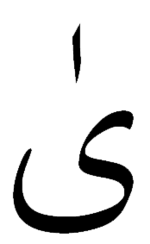Dagger alif

The Dagger alif or superscript alif (Arabic: ألف خنجرية alif khanjariyya) is written as a short vertical stroke on top of an Arabic letter. It indicates a long /aː/ sound where alif is normally not written, e.g. هٰذَا hādhā or رَحْمٰن raḥmān. The dagger alif occurs in only a few modern words, but these include some common ones; it is seldom written, however, even in fully vocalised texts, excepting the Qur'an.[1][2] As Wright notes "[alif] was at first more rarely marked than the other long vowels, and hence it happens that, at a later period, after the invention of the vowel-points, it was indicated in some very common words merely by a fètḥa [i.e. the dagger alif.]"[3] Most keyboards do not have dagger alif. The word ﷲ (Allāh) is usually produced automatically by entering "alif lām lām hāʾ". The word consists of alif + ligature of doubled lām with a shadda and a dagger alif above lām.
With fatḥah
There are two possible ways of representing the dagger alif in modern editions of Quran. In the editions printed in the Middle East the dagger alif is written with fatḥah: الرَّحْمَٰنِ (a)r-raḥmān. In the editions printed in South Asia (Pakistan, India and Bangladesh) the dagger alif is written without fatḥah: الرَّحْمٰنِ (a)r-raḥmāni.
See also
References
- ↑ Alhawary, Mohammad T. (2011). Modern standard Arabic grammar: a learner's guide. Wiley-Blackwell. pp. 17–18. ISBN 978-1-4051-5501-4.
- ↑ Ryding, Karin C. (2005). A Reference Grammar of Modern Standard Arabic. Cambridge University Press. p. 28.
- ↑ Caspari, Carl Paul (1896). Wright, William; Smith, William Robertson; de Goeje, Michael Jan, eds. A Grammar of the Arabic Language. 1 (3rd ed.). pp. 9–10.